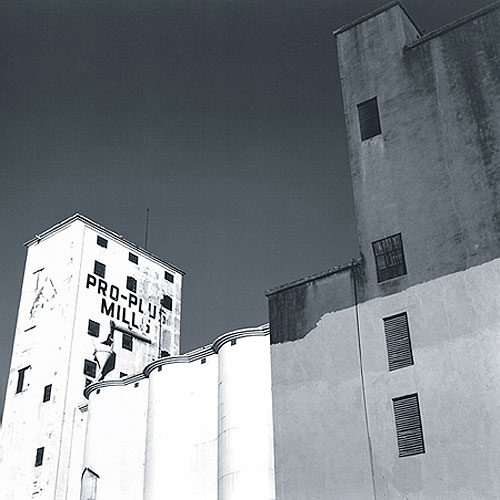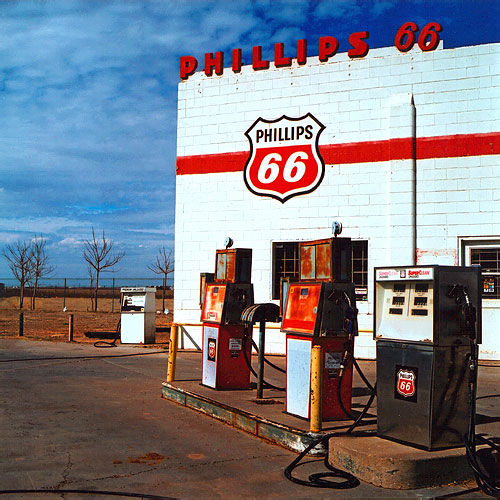I haven’t posted for awhile because I’m deep in the throes of updating my web site — I thought the break between semesters would be a good time for that. But for some reason, I always underestimate the scope of this project and it always takes so much longer than it ought to. I needed to take a breather from that and think about something else for a bit, and looking at work by other photographers is always a worthwhile endeavor.
 San Antonio, Texas, January, 2001 ©Robert L. Jones
San Antonio, Texas, January, 2001 ©Robert L. Jones
Robert L. Jones is a photographer and writer with whom I’ve corresponded off and on for a couple of years after he contacted me through my web site. I’ve not met him personally, but his work really appeals to me because a lot of it has a reverence for the same things that I am drawn to: the anachronistic image of a place that time seems to have forgotten, a chance composition discovered by looking down at the ground, and the majestic grain elevator.
This latter subject is a particular specialty of Jones’, and it’s obvious from the title he gives them that he holds them in high esteem. I’ve learned from looking at these photos that the oddly tilted perspective appearing unbidden in some of my own work is not a thing to be repudiated, but is rather something to be embraced for the dynamic presence it imparts to an image of a static subject. I’m especially intrigued by the above image because of the abrupt shift in the tonal value of the building on the right. It draws me in to thinking about what might have happened here: were they still in the process of painting this building when the photo was taken, or had they long since given up, interrupted by perhaps a financial disaster and never to return to the project? (I suppose I could research the matter and find out, but I prefer to wonder.) This demarcation line also forms a continuation of the strong diagonal started by the building on the left, creating a compelling composition.
Jones is something of a purist in his methods, preferring to work with film and doing his own developing and printing on coveted favorite papers, painstakingly working to perfect his technique, and refraining from fully accepting the label of “artist” until he feels he has done so. I find this admirable in our age of instant gratification. However, I must take just a tiny bit of exception to one thing he says in a discussion of his philosophy: “More so than any other artistic medium, photographers pride themselves in mastering technique, i.e., craft, and in perfecting each stage of the … process.” It isn’t that I don’t believe photographers do this, it’s just that I know artists in other media do so also, as I am personally aware of many textile artists who are completely obsessesed with perfecting their process. It seems that photography suffers some of the same crisis of identity that textile art suffers: is it art, or is it a craft?
I guess I’ll go out on a limb here — how could such a framing of the Phillips 66 station in its Technicolor brilliance be anything other than art?


“More so than any other artistic medium, photographers pride themselves in mastering technique, i.e., craft, and in perfecting each stage of the … process.”
Wow — such a loaded statement! What about Lomographers? What about people whose work deliberately poses as snapshot? And the “more so than” bit…either he’s trying to provoke, or he’s never seen a printmaker work on a mezzotint.
That distractive divide of art vs. craft — I think the divide is better served when focused on intent/content. I know plenty of “commercial” artists whose craft is impeccable but whose content serves commercial ends alone, and other “fine” artist whose craft is rough but whose content is sublime.
Anyway…I love coming by here and having my thoughts lit up! Thanks, and happy holidays!
What a nice thing it is to come home on Christmas and find this! Thanks for posting this, Deidre, and especially for the very sympathetic assessment of the Phillips 66 picture.
I never fail to be amazed by what people find eyebrow-raising in my writing: There is always some aside I’ve written, never meaning any offense, that raises the ire of some. Which is quite ironic, because as a writer one of my stocks in trade in writing over-the-top, combative brickbats — which hardly ever get the desired effect I wish for, because my readers realize it’s just schtick.
In defense of myself, I will say this: The operative words were “pride themselves.” This is an excerpt from a post I made originally at a photography bulletin board. I was, in fact, trying to make the case for photography as an art — as addressed to a cabal of photo gearheads.
Now, I’ve known engravers with quite an enormous amount of skill, whose work could easily be contemporaneous with Rembrandt’s. In fact, I’ve met few photographers who have the talent or skill of said engravers.
But, I’ve yet to meet a master engraver possessed of one-tenth the overweening pride of a camera club regular.
My apologies that an obliquely backhanded compliment addressed to a group of technophile photographers be interpreted as hubris on the part of this writer, as opposed to other equally (and transcendently) worthy and skillful crafts (and arts).
Hi, these are beautiful photographs. You write, ‘rather something to be embraced for the dynamic presence it imparts to an image of a static subject.’ It is strange how two different people looking at the same print will have two completely different intrepretations. To me there is movement in how these two buildings seem to be shooting out of the ground and the photographer captured them in mid air. On the other hand it seems he was trying to achieve the opposite of what most photographers do. Rather than using a deep field of focus to achieve three dimensionality he is taking a three dimensional situation (the two buildings and the sky) and trying to render them two-dimensionally. Sort of like pressing flowers in a book. Whatever he was getting at though, it works.
These comments taken together are a great reminder of how important one’s own personal point of view is when considering any matter of artistic interpretation.
Lori, you make an excellent point about intent vs. content, reminding us that there is more to think about in art besides just how competent someone is in the subtleties of a particular medium. This is what drives so many art quilters out of the judged quilt show: when the content matters not at all; but are your stitches even and do your points match up?
Robert, I didn’t really have my ire raised by the statement, but I found it a good springboard for the idea that every medium has its perfectionists. There is plenty of overweening pride in the textile art community also — a personality trait likely found in similar concentrations in every group. And I know what you mean about being surprised when people pass over what you think is going to be the controversy and instead latch on to something that you just mentioned in passing. I’ve had that experience many times. Again, this is where the person’s point of view becomes important. There’s no way to anticipate every possible viewpoint that might exist.
And Joao, your point is also very interesting. I would not have thought about the idea of flattening the dimensionality of the subject, but now that you point it out, it’s so apparent. In thinking about it, though, I am not convinced that you and I do have completely different interpretations. I think you are right that there is a lot of movement in this image. This is the opposite of my usual approach in my own work, which is to want to straighten the lines because my brain is telling me they should be straight, but it also makes the picture boring.